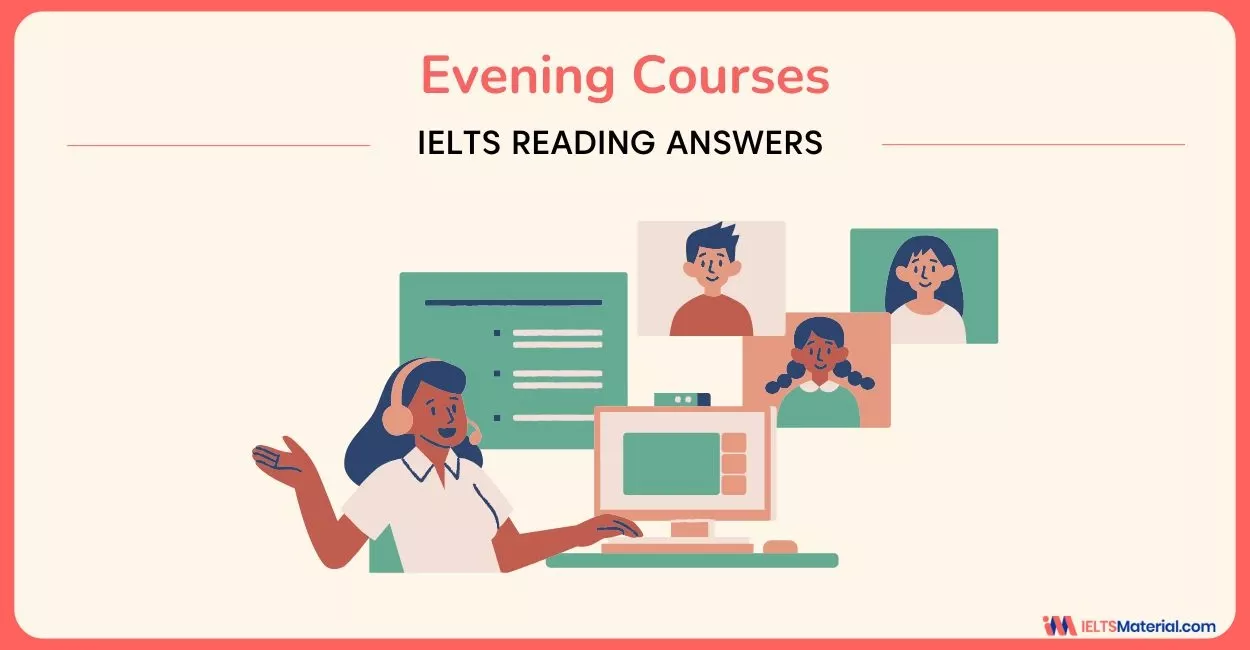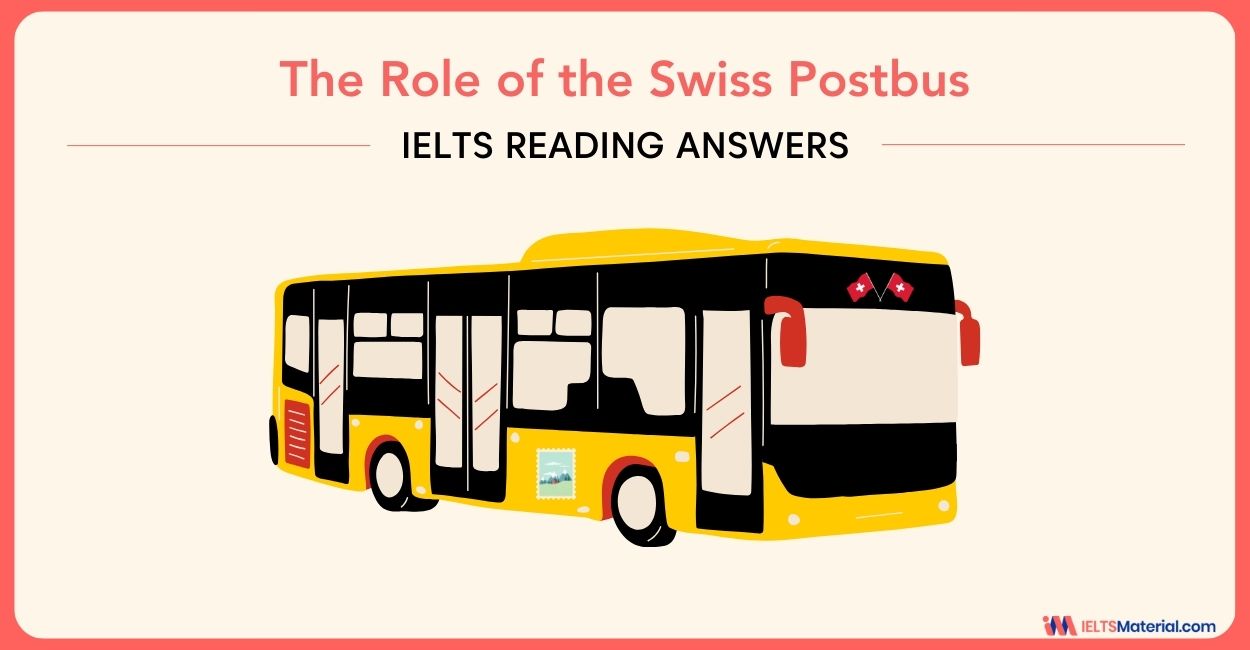The Role of the Swiss Postbus - Reading Answers for IELTS General
13 min read
Updated On
-
Copy link
Boost your practice with the IELTS General Reading passage, The Role of the Swiss Postbus, from IELTS Cambridge 14 Test 4 and get a self-check for IELTS.
Table of Contents

Limited-Time Offer : Access a FREE 10-Day IELTS Study Plan!
The IELTS General reading passage, such as ‘The Role of the Swiss Postbus’, is to be completed within a 20-minute timeframe. Achieving this requires consistent practice to develop the ability to quickly scan the provided text, identify key terms, and swiftly locate answers within this brief duration.
The passage, ‘The Role of the Swiss Postbus’, is part of Cambridge IELTS 14 General Reading Test 4 and consists of 13 questions which encompass various question types commonly found in IELTS Reading. To gain a comprehensive understanding of these question types, consider practising IELTS reading practice tests regularly.
The question types found in ‘The Role of the Swiss Postbus’ are:
- IELTS Reading Multiple-Choice Question (Q. 1-5)
- IELTS Reading True/False/Not Given (Q. 6-13)
Get quick tips to solve passages like ‘The Role of the Swiss Postbus’ in 20 minutes!
Reading Passage
The Role of the Swiss Postbus
Switzerland’s postbuses are much more than just a means of public transportation.
The Swiss PostBus Limited is the largest of the country’s 78 coach companies. Administered by the Motor Services Department of the Post Office, it carries over 120 million passengers each year and is carefully integrated with other public transport services: trains, boats and mountain cableways. The Swiss transportation system resembles a tree, with the larger branches representing federal and private railways, the smaller branches being the coaches, and the twigs being the urban transit operators running trams, city buses, boats, chairlifts and so on. But the trunk that holds the tree together is the vast postbus network, without which the whole network would not function.
There isn’t an inhabited place in Switzerland that cannot be reached by some sort of public transport. Federal law and the Swiss Constitution stipulate that every village with a population greater than 40 is entitled to regular bus services. The frequency of these services is directly related to population density. Timetables are put together four years in advance, and seldom change. If a new route is to be introduced, the population of the area affected is invited to vote in a referendum.
At times, postbuses are the main — sometimes the only — links between settlements. These coaches, often with a trailer in tow to increase their capacity, are a common sight in high-altitude regions, and their signature sound — part of Rossini’s William Tell Overturn, played by the drivers on three-tone post horns with electrical compressors at every road turn — is one of the most familiar Swiss sounds.
The three-tone horns can still be used to ‘talk’ to post offices (and each other) from a distance. By altering the combination of the tones, a driver can announce ‘departure of post1′, ‘arrival of post’, ‘arrival of special post’, and so on – so much more romantic and often more reliable than radio or mobile phones. This musical ‘language’ started in the mid-nineteenth century, when the coach drivers could also blow their horns a certain number of times on approaching the station to indicate the number of horses needing to be fed, giving the stationmaster time to prepare the fodder.
The postbus history goes back to 1849, when the Swiss postal service was made a monopoly. The role of today’s modern yellow buses was, back then, played by horse-drawn carriages (or in winter by sleighs, in order to travel on snow), which were the same colour. By 1914, eight years after the first motor coaches were introduced, there were still 2,500 horses, 2,231 coaches (or carriages) and 1,059 sleighs in service.
After the First World War, Swiss Post bought a fleet of decommissioned military trucks which were converted into postbuses, but it was not until 1961 that the last horse-drawn coach was replaced with a motorised version.
Today, the Swiss Post Office boasts one of the world’s most advanced coach fleets, including fuel-cell models and the world’s first driverless bus. This was launched in 2015 in the town of Sion, the capital of the canton of Valais, one of the 26 cantons, or administrative regions, that make up the country.
Postbuses often go to places that other means of transport cannot reach. Most of the drivers therefore see themselves as educators and tour guides. Although it’s not in their job description, they’re likely to point out the sights — waterfalls, gorges, and so on — and are always ready to pull over for a photo opportunity.
Switzerland’s longest postbus journey, and one of the highest, crosses four mountain passes – an eight-hour trip undertaken by a single postbus. The route goes through several cantons; two languages (German and Italian); all four seasons – from burning sunshine to showers and heavy snowfalls; and countless places of interest. One of the passes, the Gotthard, is often described as ‘the People’s Road’, probably because it connects the German-speaking canton of Uri with Italian-speaking Ticino. Like Switzerland itself, postbuses ‘speak’ all four state languages: German, French, Italian and Romansh – and by law, their automated intercom announcements are given in the language of whichever canton the bus is currently passing through.
Irrespective of their previous driving experience, drivers undergo lots of training. During the first year, they have to drive postbuses under the supervision of a more experienced driver. Only after two years of safe driving in the valleys can they be pronounced ready for a mountain bus.
Some routes are not at all busy, with the bus often carrying just two or three passengers at a time. But for most people living in small mountain villages, the postbus is of the utmost importance. It not only carries the villagers to town and back, it takes village children to and from school, delivers mail, transports milk from the village farms down to the valley, collects rubbish from the village (Swiss laws do not allow dumping anywhere in the mountains), and brings building materials to households. It takes elderly villagers to shops and carries their shopping up the hill to their homes. More a friend than just a means of transportation, for the dwellers of mountain villages the postbus is an essential part of life.
Questions 1- 5
Choose the correct letter, A, B, C or D.
Write the correct letter in boxes 1-5 on your answer sheet.
1 When comparing the Swiss transportation system to a tree, the writer emphasises
A the size of the postbus system.
B how competitive the postbus system is.
C how important the postbus system is.
D the threat to the postbus system.
2 What is said about bus services in the second paragraph?
A Villages have the chance to request more buses every four years.
B New routes are often introduced to reflect an increase in population.
C Bus timetables tend to change every four years.
D The number of buses that call at a village depends on how many people live there.
3 According to the fourth paragraph, what were three-tone horns first used to indicate?
A how many coach horses required food
B how long the bus would stay at the station
C how many passengers wanted a meal
D how soon the bus would arrive at the station
4 What point does the writer make about the postbus drivers?
A Many choose to give passengers information about the surroundings.
B Most are proud of driving buses to places without other forms of transport.
C They are required to inform passengers about the sights seen from the bus.
D They are not allowed to stop for passengers to take photographs.
5 What is said about the buses’ automated announcements?
A They are given in the language of the bus’s starting point.
B The language they are given in depends on where the bus is at the time.
C They are always given in all the four languages of Switzerland.
D The language they are given in depends on the bus’s destination.
Questions 6-13
Do the following statements agree with the information given in the text above?
In boxes 6-13 on your answer sheet, write
TRUE if the statement agrees with the information
FALSE if the statement contradicts the information
NOT GIVEN if there is no information on this
6Some postbuses after the First World War were originally army vehicles.
7 The number of driverless buses has increased steadily since 2015.
8 On the longest postbus route in Switzerland, passengers have to change buses.
9 The weather on the longest postbus route is likely to include extreme weather conditions.
10 There is a widely used nickname for part of the longest route used by postbuses.
11 Bus drivers’ training can be shortened if they have driven buses before joining PostBus.
12 In some villages most passengers are school children.
13 Buses carry only rubbish that can be recycled.
Seeking an exclusive IELTS Reading Guide with more tests like ‘The Role of the Swiss Postbus’?
Answers for The Role of the Swiss Postbus Reading Passage with Location and Explanations
1 Answer: C
Question type: Multiple-Choice Question
Answer location: Paragraph 1, Line 4
Answer explanation: The selected line reveals, “But the trunk that holds the tree together is the vast postbus network, without which the whole network would not function.”. This tells us that by comparing the Swiss transportation system with a tree, the author wants to specify the importance of the Postbus system. Hence, the answer is C (how important the postbus system is.).
2 Answer: D
Question type: Multiple-Choice Question
Answer location: Paragraph 2, Line 3
Answer explanation: In the quoted line of Paragraph 2, it is declared, “The frequency of these services is directly related to population density.”. This points to the fact that the number of buses that connect a village depends on the number of people living there (population density). Hence, the answer is D (The number of buses that call at a village depends on how many people live there.).
3 Answer: A
Question type: Multiple-Choice Question
Answer location: Paragraph 4, Line 3
Answer explanation: In the highlighted line of Paragraph 4, it is reported that “…when the coach drivers could also blow their horns a certain number of times on approaching the station to indicate the number of horses needing to be fed, giving the stationmaster time to prepare the fodder.”. This proves the fact that in earlier times three-fourth of the horns used to indicate the number of the horses that required food so that the stationmaster could arrange for fodder. Hence, the answer is A (how many coach horses required food).
4 Answer: A
Question type: Multiple-Choice Question
Answer location: Paragraph 8, Line 2
Answer explanation: In the quoted section, it is communicated that “Most of the drivers therefore see themselves as educators and tour guides.”. It indicates that although it is not part of their job description, most Postbus drivers act as a guide for the passengers and explain the surroundings. Hence, the answer is A (Many choose to give passengers information about the surroundings.).
5 Answer: B
Question type: Multiple-Choice Question
Answer location: Paragraph 9, Line 3
Answer explanation: In the cited paragraph, it is given, “…and by law, their automated intercom announcements are given in the language of whichever canton the bus is currently passing through.”. It can be deduced that the language of the automated announcements in the postbus depends on the place they are in at that time. Hence, the answer is B (The language they are given in depends on where the bus is at the time.).
6 Answer: True
Question type: True/False/Not Given
Answer location: Paragraph 6
Answer explanation: From the specified location, “After the First World War, Swiss Post bought a fleet of decommissioned military trucks which were converted into postbuses…”, it can be concluded that after the First World War ended, the Postbuses were used as army vehicles (military trucks). As the statement agrees with the information, the answer is True.
7 Answer: Not Given
Question type: True/False/Not Given
Answer location: N.A.
Answer explanation: Although there is a mention of the introduction of the first driverless bus in 2015, it is not specified if the number of those buses increased or not. Hence, the answer is Not Given.
8 Answer: False
Question type: True/False/Not Given
Answer location: Paragraph 9, Line 1
Answer explanation: The given line of Paragraph 9 reads, “Switzerland’s longest postbus journey, and one of the highest, crosses four mountain passes – an eight-hour trip undertaken by a single postbus.”. It is clear that on the longest postbus route in Switzerland, passengers do not have to change buses as it was covered by a single postbus. As the statement contradicts the information, the answer is False.
9 Answer: True
Question type: True/False/Not Given
Answer location: Paragraph 9, Line 2
Answer explanation: The given line of Paragraph 9 states that “The route goes through several cantons; two languages (German and Italian); all four seasons – from burning sunshine to showers and heavy snowfalls; and countless places of interest.”. From the quoted line, it is clear that the longest route in Switzerland has to go through extreme weather conditions (from burning sunshine to showers and heavy snowfalls) in all four seasons. As the statement agrees with the information, the answer is True.
10 Answer: True
Question type: True/False/Not Given
Answer location: Paragraph 9, Line 3
Answer explanation: The following line of the specified paragraph mentions, “One of the passes, the Gotthard, is often described as ‘the People’s Road’, probably because it connects the German-speaking canton of Uri with Italian-speaking Ticino.”. This makes it clear that a section of the longest route in Switzerland has a nickname (the People’s Road). As the statement agrees with the information, the answer is True.
11 Answer: False
Question type: True/False/Not Given
Answer location: Paragraph 10, Line 1
Answer explanation: The line of Paragraph 10 affirms that “Irrespective of their previous driving experience, drivers undergo lots of training.”. It can be concluded that postbus drivers had to undergo training irrespective of the fact that they had previous bus driving experience. As the statement contradicts the information, the answer is False.
12 Answer: Not Given
Question type: True/False/Not Given
Answer location: N.A.
Answer explanation: Although there are mentions of children taking the postbus to go to schools, it is not specified if these school children consist of maximum passengers or not. Hence, the answer is Not Given.
13 Answer: Not Given
Question type: True/False/Not Given
Answer location: N.A.
Answer explanation: Although it is mentioned in the concluding paragraph that buses collect rubbish from the village as the Swiss government does not allow dumping waste in the mountains, there is no mention if they carry only recyclable waste. Hence, the answer is Not Given.
Check Out – IELTS Books to Use During IELTS Preparation in 2025
Tips to Solve the Question Types in The Role of the Swiss Postbus IELTS Reading Answers
Since now you know the answers to The Role of the Swiss Postbus Reading Answers with explanations, let us check out some quick tips to answer the two types of questions in the General Reading Answers of The Role of the Swiss Postbus.
Multiple-Choice Questions:
You will be given a reading passage followed by several questions based on the information in the paragraph in multiple-choice questions. Your task is to understand the question and compare it to the paragraph in order to select the best solution from the available possibilities.
- Before reading the passage, read the question and select the keywords. Check the keyword possibilities if the question statement is short on information.
- Then, using the keywords, read the passage to find the relevant information.
- To select the correct option, carefully read the relevant words and match them with each option.
- You will find several options with keywords that do not correspond to the information.
- Try opting for the elimination method mostly.
- Find the best option by matching the meaning rather than just the keywords.
True/False/Not Given
In IELTS Reading, ‘True, False, Not Given’ questions are based on facts. Several factual statements will be provided to you, and it is up to you to determine whether or not they are accurate by reading the text.
To answer this type of question, you can use the following strategies:
- Read the question and identify the keywords – Before reading the material, have a look at your list of True, False, and Not Given questions.
- Scan the passage for synonyms or paraphrased words of the keywords – When you have highlighted the keywords, swiftly read the text to look for paraphrases or synonyms.
- Match the highlighted words in the questions with their synonyms in the text – Once you find both sets of keywords, cross-check them to find the answer.
- Identify the answer – If the facts match, the answer is TRUE, and in case it doesn’t match, it is FALSE. If you are unable to find the answer or unsure of it, mark it NOT GIVEN.
Also Check:
- The Birdmen Reading Answers for IELTS General
- IELTS Reading – Keyword Techniques – How to Use
- Mass Appeal of the Manta Rays – IELTS General Reading Answers
- The Water Crisis Reading Answers for IELTS General
- Best IELTS Reading Books 2025
- Fordlandia Reading Answers for IELTS 2025
- How to get 8 bands in IELTS?

Start Preparing for IELTS: Get Your 10-Day Study Plan Today!
General Reading Practice Tests


Nehasri Ravishenbagam

Kasturika Samanta

Nehasri Ravishenbagam
Recent Articles

Kasturika Samanta

Kasturika Samanta






Post your Comments